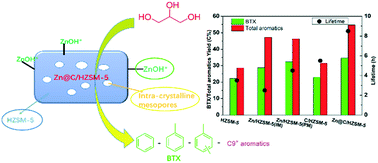A highly active and stable Zn@C/HZSM-5 catalyst using Zn@C derived from ZIF-8 as a template for conversion of glycerol to aromatics†
Abstract
A highly active and stable Zn@C/HZSM-5 catalyst with active Zn species and intra-crystalline mesopores for glycerol to aromatics (GTA) was prepared by addition of a Zn@C porous carbon template derived from ZIF-8 into the zeolite synthesis process. XRD, UV-vis DRS, ICP-OES, XPS, TEM, BET, TPD, Py-IR, TGA, and TPO were used to elucidate the correlation between the physicochemical properties and the catalytic performances of the resultant catalysts. The introduced Zn species significantly improved the catalytic activity of Zn@C/HZSM-5 due to the formed Zn-Lewis acid (ZnOH+), which could enhance the aldol condensation and dehydrogenation–aromatization steps in the GTA reaction. Furthermore, the catalytic stability of Zn@C/HZSM-5 was also obviously improved for the simultaneous incorporation of intra-crystalline mesopores. Compared with the inherent micropores in bare HZSM-5, the introduced intra-crystalline mesopores in Zn@C/HZSM-5 not only promoted the diffusion of bulky molecules in zeolite channels and further slowed down coke formation, but also provided more mesopore volume to resist coke deposition, which finally slowed down the catalyst deactivation. Moreover, the Zn introduction methods had significant influences on the Zn state, acidic properties and subsequent catalytic performances of the Zn-modified catalysts. In Zn/HZSM-5(IM) prepared by impregnation, majority of Zn species existed as ZnOH+, and this only remarkably enhanced the aldol condensation step (liquid route), which only resulted in an obvious improvement of the C9 aromatic yield. Whereas in Zn/HZSM-5(PM) prepared by physical mixing, a small fraction of Zn species existed as ZnOH+, which only significantly enhanced the oligomerization step (gas route), leading to a large improvement in the BTX yield. In comparison, Zn@C/HZSM-5 possessed the appropriate ZnOH+ species, which could obviously enhance both the aldol condensation step and oligomerization step in GTA, thus resulting in a superior total aromatics yield for the simultaneous improvements of the BTX yield and C9 aromatic yield. Finally, nearly 100% carbon conversion and 54.7% total aromatics yield were obtained over the stable Zn@C/HZSM-5 with an 8.5 h lifetime due to the synergy between the Zn-Lewis acid (ZnOH+), intra-crystalline mesopores and HZSM-5 zeolite.



 Please wait while we load your content...
Please wait while we load your content...